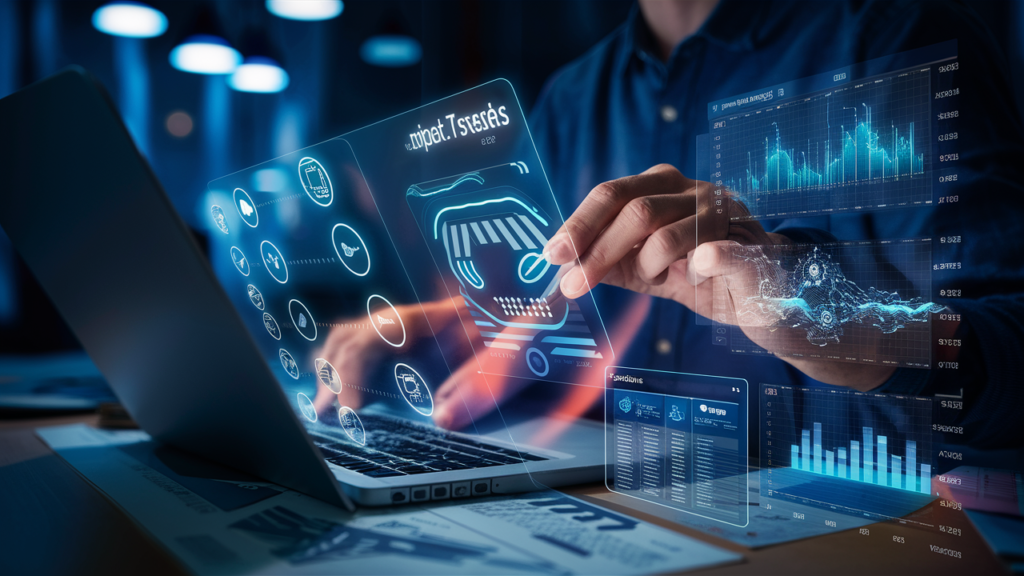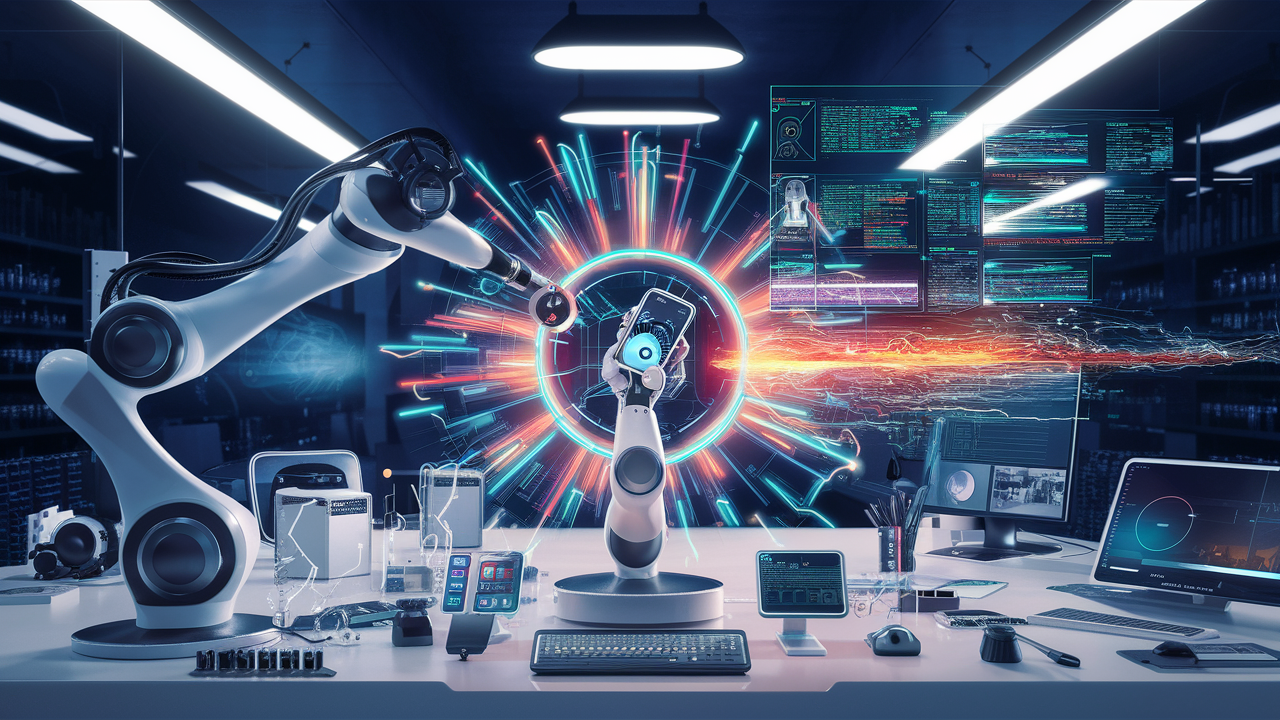In today’s fast-paced software development environment, staying ahead of the curve requires embracing innovative tools and methodologies. Artificial Intelligence (AI) has become a game-changer, particularly in software testing.
This blog post explores the numerous advantages of using AI in software testing, showcasing how it can enhance test coverage, reduce costs, and accelerate time-to-market, among other benefits.
What is AI in Software Testing?
AI in software testing involves the application of machine learning (ML), natural language processing (NLP), and other AI technologies to automate and enhance the software testing process. Unlike traditional testing methods, which rely heavily on human intervention, AI-driven testing tools can learn from data, predict outcomes, and optimize testing strategies.
How AI Works in Software Testing

AI-powered testing tools analyze historical data, identify patterns, and apply this knowledge to new testing scenarios. This process includes:
- Test Case Generation: AI tools can automatically generate test cases by analyzing application requirements and user stories.
- Test Execution: Automated testing scripts are executed by AI, which adapts to changes in the application without manual intervention.
- Defect Prediction: AI predicts potential defects and prioritizes them based on risk, enabling more efficient testing.
Why AI is Crucial for Modern Software Testing
As software systems become increasingly complex, traditional testing methods struggle to keep pace. AI addresses these challenges by providing:
- Scalability: AI can handle large datasets and complex systems that would overwhelm manual testing.
- Speed: Automated AI-driven testing can execute thousands of tests in a fraction of the time it would take a human tester.
- Accuracy: AI minimizes human error, ensuring more reliable test results.
1. Enhanced Test Coverage
One of the most significant benefits of AI in software testing is the ability to achieve enhanced test coverage. AI tools can test more scenarios, platforms, and environments than traditional methods, ensuring that all aspects of the software are thoroughly examined.
Comprehensive Coverage Across Multiple Platforms
AI-driven tools can simulate and test applications across different platforms, devices, and operating systems. For instance, an AI tool might automatically test a mobile app on various iOS and Android versions, ensuring compatibility and functionality.
Example of AI-Driven Test Coverage
| Platform | OS Version | Test Scenarios Covered |
|---|---|---|
| Android | 10, 11, 12 | UI/UX, Performance, Security, Compatibility |
| iOS | 14, 15, 16 | Functionality, Responsiveness, Battery Usage |
| Web Browsers | Chrome, Safari, Firefox | Cross-Browser Functionality, Layout Consistency |
Real-World Example: AI in Cross-Browser Testing
A leading e-commerce company used AI-driven testing tools to test its website across multiple browsers. The AI system identified browser-specific issues, such as layout inconsistencies and slow loading times, that would have been missed by manual testing. As a result, the company improved its website’s user experience, leading to a 15% increase in customer satisfaction.
2. Accelerated Time-to-Market
In the competitive world of software development, getting your product to market quickly is crucial. AI in software testing plays a pivotal role in reducing time-to-market by automating time-consuming tasks and enabling faster feedback loops.
How AI Reduces Testing Time
AI automates repetitive tasks, such as test case execution and regression testing, which significantly reduces the time required to complete testing cycles. Additionally, AI’s ability to adapt to changes in the software without manual intervention means that testing can keep pace with rapid development cycles.
Case Study: Reducing Time-to-Market with AI
A fintech company integrated AI into its testing process to accelerate the release of a new mobile banking app. By automating regression testing and utilizing AI’s predictive capabilities, the company reduced its testing time by 40%, allowing them to launch the app three weeks ahead of schedule.
3. Increased Accuracy and Precision
Manual testing is prone to human error, which can lead to missed defects and inaccurate test results. AI, on the other hand, offers unparalleled accuracy and precision in software testing.
Minimizing Human Error
AI algorithms are designed to follow strict rules and patterns, ensuring that tests are executed consistently and without the oversight that might lead to errors. This results in more reliable and precise test outcomes.
Supporting Data: AI vs. Manual Testing Accuracy
Studies show that AI-driven testing tools can achieve up to 90% accuracy in detecting defects, compared to 70% accuracy with manual testing. This increase in accuracy leads to higher-quality software and fewer post-release bugs.
4. Continuous Testing and Integration
Continuous testing is a cornerstone of modern software development practices like DevOps. AI supports continuous testing by enabling automated, real-time testing throughout the development lifecycle.
Seamless Integration with CI/CD Pipelines
AI-driven testing tools integrate easily with Continuous Integration/Continuous Deployment (CI/CD) pipelines, ensuring that testing is continuous, automated, and aligned with the development process.
Example: Continuous Testing with AI
A SaaS company incorporated AI into its CI/CD pipeline to automate the testing of new features as they were developed. This integration allowed the company to identify and fix issues early in the development process, reducing the number of defects found in production by 25%.
5. Cost Efficiency
While the initial investment in AI-driven testing tools may be higher, the long-term cost savings are significant. AI in software testing is cost-efficient because it optimizes resources and reduces the need for extensive manual labor.
Optimizing Resource Allocation
AI automates labor-intensive tasks, freeing up human testers to focus on more complex, value-added activities. This not only reduces labor costs but also improves the overall efficiency of the testing process.
List: Ways AI Reduces Costs in Software Testing
- Automates repetitive tasks
- Reduces the need for manual testing
- Minimizes post-release defects and associated costs
- Shortens time-to-market, reducing development costs
Cost Analysis: AI vs. Traditional Testing
| Cost Factor | Traditional Testing | AI-Driven Testing |
|---|---|---|
| Labor Costs | High | Low |
| Defect Resolution Costs | High | Low |
| Time-to-Market | Longer | Shorter |
| Overall Testing Costs | Higher | Lower |
6. Better Test Data Management
Effective test data management is critical for accurate and reliable testing. AI enhances test data management by generating, selecting, and organizing test data more efficiently than manual methods.
AI’s Role in Test Data Generation
AI can automatically generate test data based on the application’s requirements, ensuring that all possible scenarios are tested. This includes edge cases, which are often overlooked in manual testing.
Practical Application: AI in Test Data Management
A healthcare software company used AI to manage test data for its patient management system. The AI tool generated diverse test data sets, covering a wide range of patient scenarios, leading to more thorough testing and fewer post-launch issues.
7. Predictive Analytics for Risk Management
Predictive analytics is one of the most powerful features of AI in software testing. AI uses historical data to predict potential defects and risks, enabling more targeted and efficient testing.
Risk-Based Testing with AI
AI-driven tools can prioritize testing efforts based on the predicted risk level, ensuring that the most critical areas of the application are tested first. This approach reduces the likelihood of critical defects going unnoticed.
AI-Powered Risk-Based Testing Prioritization
| Feature | Predicted Risk Level | Testing Priority |
|---|---|---|
| User Authentication | High | High |
| Payment Processing | Medium | Medium |
| User Interface (UI) | Low | Low |
Risk Mitigation Example
A large financial institution implemented AI-driven predictive analytics to prioritize testing of its online banking platform. By focusing on high-risk areas, the bank reduced the number of critical defects in production by 30%, significantly improving system reliability.
8. Continuous Learning and Improvement
AI systems are designed to learn from previous test cycles, continuously improving their effectiveness. This continuous learning capability allows AI-driven testing tools to adapt to new challenges and optimize testing strategies over time.
Adaptive Testing with AI
AI tools can analyze past testing data to identify areas for improvement, such as refining test cases or adjusting testing parameters. This ensures that testing processes evolve alongside the software, maintaining high standards of quality.
Example: Continuous Improvement with AI
A global e-commerce platform used AI to continuously learn from its testing cycles. Over time, the AI tool refined its testing strategies, leading to a 20% reduction in test execution time and a 15% improvement in defect detection rates.
Challenges and Considerations
While the benefits of AI in software testing are substantial, there are also challenges to consider. Implementing AI requires a thoughtful approach to ensure that it delivers the desired results.
Common Challenges
- Initial Investment: The cost of implementing AI-driven tools can be high.
- Complexity: AI systems can be complex to set up and require skilled personnel to manage.
- Data Quality: AI’s effectiveness depends on the quality of the data it processes. Poor data can lead to inaccurate predictions and results.
9. Enhanced User Experience
AI-driven testing significantly improves user experience by ensuring that applications perform optimally and provide a seamless experience for users.
User Experience Testing
AI tools can simulate a wide range of user interactions and behaviors, ensuring that the application performs well under various conditions. This includes testing for responsiveness, usability, and overall user satisfaction.
Example: AI in User Experience Testing
Consider an e-commerce platform with complex user workflows, such as product search, filtering, and checkout. AI can simulate various user paths, including common and unusual interactions, to identify any issues that might affect the user experience. By detecting and addressing these issues early, the platform can provide a smoother and more intuitive experience for its users.
Behavioral Analytics
AI tools analyze user behavior patterns and feedback to continuously refine the application’s functionality and usability. This analysis helps identify pain points and areas for improvement, leading to enhancements that align with user needs and expectations.
Fact: User Experience Improvement with AI
Studies show that applications using AI-driven testing for user experience can see up to a 40% increase in user satisfaction ratings, as they address usability issues before the software reaches end users.
10. Improved Test Maintenance
Maintaining and updating test cases can be a daunting task, especially as applications evolve. AI simplifies test maintenance by automating the process and adapting to changes in the application.
Automated Test Maintenance
AI tools can automatically update test cases based on changes in the application’s code or functionality. When a new feature is added or an existing feature is modified, AI tools adjust the corresponding test cases to ensure they remain relevant and effective.
Example: AI-Driven Test Maintenance
For a software application that undergoes frequent updates, AI-driven testing tools can automatically adjust test scripts and scenarios to match the latest version of the software. This reduces the manual effort required to maintain test cases and ensures that the tests remain aligned with the current state of the application.
Adaptive Test Suites
AI enables the creation of adaptive test suites that evolve based on testing results and application changes. This adaptability helps maintain the effectiveness of the test suite over time, reducing the risk of outdated or irrelevant tests.
Table: Test Maintenance Comparison
| Maintenance Aspect | Manual Testing | AI-Driven Testing |
|---|---|---|
| Test Case Updates | Manual and Time-Consuming | Automated and Efficient |
| Handling Application Changes | Labor-Intensive | Dynamic and Adaptive |
| Test Suite Relevance | Potentially Outdated | Continuously Aligned |
11. Enhanced Security Testing
Security is a critical aspect of software quality, and AI enhances security testing by identifying vulnerabilities and threats that may not be apparent through traditional testing methods.
Vulnerability Detection
AI-driven tools can analyze code and application behavior to identify potential security vulnerabilities. This includes detecting weaknesses such as SQL injection, cross-site scripting (XSS), and other common security issues.
Example: AI in Security Testing
A financial services application using AI for security testing can automatically scan for vulnerabilities in its codebase and identify potential security threats in real time. This proactive approach helps ensure that the application remains secure against evolving threats.
Threat Simulation
AI tools can simulate various types of cyberattacks and security threats to test the application’s resilience. By mimicking real-world attack scenarios, these tools help organizations assess their security posture and improve their defenses.
Fact: AI and Security Testing
Research indicates that AI-driven security testing can reduce the time needed to identify and address vulnerabilities by up to 60%, compared to traditional security testing methods.
Table: Security Testing Benefits
| Security Aspect | Traditional Testing | AI-Driven Testing |
|---|---|---|
| Vulnerability Detection | Manual Scanning | Automated and Comprehensive |
| Threat Simulation | Limited Scenarios | Extensive and Realistic |
| Response Time | Longer | Faster and More Efficient |
Conclusion
The integration of AI into software testing brings substantial benefits, including enhanced test coverage, accelerated time-to-market, increased accuracy, and cost efficiency. By leveraging AI-driven tools, organizations can overcome the limitations of traditional testing methods and achieve higher-quality software products.
As software development continues to evolve, AI will play an increasingly important role in testing, providing new opportunities for improving efficiency, accuracy, and overall software quality. Embracing AI in software testing is not just a trend but a strategic advantage in today’s competitive landscape.
Related Resources
- AI in Software Testing: A Comprehensive Guide
- The Future of Testing: AI-Driven Tools and Strategies
- Case Study: How AI Improved Software Testing for a Leading E-Commerce Platform
- AI-Enhanced User Experience Testing: A GuideThe Future of Test Maintenance: AI InnovationsStrengthening Application Security with AI Tools

Nicholas Clark is the innovative mind behind Insuranted.com, a website dedicated to providing clear, comprehensive, and reliable information on insurance. With a passion for simplifying complex topics, Nicholas aims to empower readers to make informed decisions about their insurance needs










